Biscuits with Oleogels and Green Tea Extract Addition––Sensory Evaluation and Consumer Perception
Abstract
Featured Application
Abstract
1. Introduction
2. Materials and Methods
2.1. Materials
2.2. Oleogels Preparation
2.3. Preparation of Short-Dough Biscuits
2.4. Sensory Analysis
2.5. Survey and Consumer “Blind” Test
2.6. Fatty Acids Analysis
2.7. Nutritional Index of HORO and PF
2.8. Statistical Analysis
3. Results and Discussion
3.1. Nutritional Value of Palm Fat and High-Oleic Rapeseed Oil
3.2. Sensory Analysis Results
3.3. Principal Component Analysis of Sensory Evaluation
3.4. Analysis of Consumer Awareness and Preferences Regarding Short-Dough Biscuits
3.5. Estimated Overall Quality, Nutritional Value, and Purchase Intention Based on the Composition of Short-Dough Biscuits
4. Conclusions
5. Patents
Author Contributions
Funding
Institutional Review Board Statement
Informed Consent Statement
Data Availability Statement
Conflicts of Interest
Abbreviations
| HORO | High-oleic rapeseed oil |
| PF | Palm fat |
| EC | Ethylcelullouse |
| CLX | Candelilla wax |
| MAG | Monoacylglycerol |
| GTE | Green tea extract |
| FA | Fatty acid |
| TFA | Trans fatty acid |
References
- Thakur, D.; Suhag, R.; Singh, A.; Upadhyay, A.; Prabhakar, P.K.; Sharma, A. Comparative Evaluation of Soybean Oil-Carnauba Wax Oleogel as an Alternative to Conventional Oil for Potato Chips Frying. Food Struct. 2023, 37, 100334. [Google Scholar] [CrossRef]
- Zbikowska, A.; Onacik-Gür, S.; Kowalska, M.; Sowiński, M.; Szymańska, I.; Żbikowska, K.; Marciniak-Łukasiak, K.; Werpachowski, W. Analysis of Stability, Rheological and Structural Properties of Oleogels Obtained from Peanut Oil Structured with Yellow Beeswax. Gels 2022, 8, 448. [Google Scholar] [CrossRef]
- Kim, J.Y.; Lim, J.; Lee, J.; Hwang, H.; Lee, S. Utilization of Oleogels as a Replacement for Solid Fat in Aerated Baked Goods: Physicochemical, Rheological, and Tomographic Characterization. J. Food Sci. 2017, 82, 445–452. [Google Scholar] [CrossRef]
- Alongi, M.; Lopriore, M.; Calligaris, S.; Manzocco, L.; Nicoli, M.C. Identifying the Acceptability Limit for Shelf-Life Assessment of Potato Chips: Mismatching between Quality and Safety Issues. J. Food Eng. 2023, 357, 111645. [Google Scholar] [CrossRef]
- Onacik-Gür, S.; Zbikowska, A.; Przybysz, M.; Kowalska, M. Assessment of Physical Properties of Structured Oils and Palm Fat. Mater. Plast. 2017, 54, 800–805. [Google Scholar] [CrossRef]
- Pang, M.; Kang, S.; Liu, L.; Ma, T.; Zheng, Z.; Cao, L. Physicochemical Properties and Cookie-Making Performance as Fat Replacer of Wax-Based Rice Bran Oil Oleogels. Gels 2022, 9, 13. [Google Scholar] [CrossRef] [PubMed]
- Flöter, E.; Wettlaufer, T.; Conty, V.; Scharfe, M. Oleogels—Their Applicability and Methods of Characterization. Molecules 2021, 26, 1673. [Google Scholar] [CrossRef]
- Ferdaus, M.J.; Mahmud, N.; Talukder, S.; Silva, R.C.D. Characteristics and Functional Properties of Bioactive Oleogels: A Current Review. Gels 2025, 11, 69. [Google Scholar] [CrossRef]
- Tan, T.H.; Chan, E.; Manja, M.; Tang, T.; Phuah, E.; Lee, Y. Production, Health Implications and Applications of Oleogels as Fat Replacer in Food System: A Review. J. Am. Oil Chem. Soc. 2023, 100, 681–697. [Google Scholar] [CrossRef]
- Abe, A.A.; Aiello, I.; Oliviero Rossi, C.; Caputo, P. Oleogels: Uses, Applications, and Potential in the Food Industry. Gels 2025, 11, 563. [Google Scholar] [CrossRef]
- Li, L.; Liu, G.; Bogojevic, O.; Pedersen, J.N.; Guo, Z. Edible Oleogels as Solid Fat Alternatives: Composition and Oleogelation Mechanism Implications. Comp. Rev. Food Sci. Food Safe 2022, 21, 2077–2104. [Google Scholar] [CrossRef]
- Zhao, W.; Wei, Z.; Xue, C. Recent Advances on Food-Grade Oleogels: Fabrication, Application and Research Trends. Crit. Rev. Food Sci. Nutr. 2022, 62, 7659–7676. [Google Scholar] [CrossRef]
- Manzoor, S.; Masoodi, F.A.; Naqash, F.; Rashid, R. Oleogels: Promising Alternatives to Solid Fats for Food Applications. Food Hydrocoll. Health 2022, 2, 100058. [Google Scholar] [CrossRef]
- Mehany, T.; Zannou, O.; Oussou, K.F.; Chabi, I.B.; Tahergorabi, R. Innovative Oleogels: Developing Sustainable Bioactive Delivery Systems for Healthier Foods Production. Food Chem. X 2025, 29, 102768. [Google Scholar] [CrossRef] [PubMed]
- Kupiec, M.; Zbikowska, A.; Marciniak-Lukasiak, K.; Zbikowska, K.; Kowalska, M.; Kowalska, H.; Rutkowska, J. Study on the Introduction of Solid Fat with a High Content of Unsaturated Fatty Acids to Gluten-Free Muffins as a Basis for Designing Food with Higher Health Value. Int. J. Mol. Sci. 2021, 22, 9220. [Google Scholar] [CrossRef] [PubMed]
- Onacik-Gür, S.; Żbikowska, A. Effect of High-Oleic Rapeseed Oil Oleogels on the Quality of Short-Dough Biscuits and Fat Migration. J. Food Sci. Technol. 2020, 57, 1609–1618. [Google Scholar] [CrossRef]
- Onacik-Gür, S.; Zbikowska, A. The Effect of Green Tea Extract and Oleogels on the Physico-Chemical Properties and Oxidative Stability of Short-Dough Biscuits during Storage. LWT 2022, 172, 114197. [Google Scholar] [CrossRef]
- Baştürk, A.; Badem, Ş.; Ceylan, M.M. Propolis and Carnauba Wax-based Safflower Oil Oleogels as Fat Substitutes in Cakes: Production, Oxidative Stability, and Characterization. Eur. J. Lipid Sci. Technol. 2023, 125, 2200213. [Google Scholar] [CrossRef]
- Banaś, K.; Piwowar, A.; Harasym, J. Agar-Rapeseed Oil Hydroleogels as Solid Fat Substitute in Short-Bread Cookies. Food Hydrocoll. 2024, 151, 109889. [Google Scholar] [CrossRef]
- Zulfiqar, A.; Shabbir, M.A.; Tahir, F.; Khan, M.R.; Ahmed, W.; Yıkmıs, S.; Manzoor, M.F.; Abdi, G.; Aadil, R.M. Development of oleogel by structuring the blend of corn oil and sunflower oil with beeswax to replace margarine in cookies. Food Chem. 2024, 23, 101676. [Google Scholar] [CrossRef]
- WHO: World Health Organization; Global Health Observatory (GHO). Overweight and Obesity. Available online: https://www.who.int/news-room/fact-sheets/detail/obesity-and-overweight (accessed on 2 July 2025).
- Arshad, R.; Mazhar, F.B.; Arshad, K.; Xu, B. Unlocking the Potential of Oleogels in Edible Applications and Health Impacts. Appl. Food Res. 2024, 4, 100620. [Google Scholar] [CrossRef]
- Sharma, S.; Cheng, S.-F.; Bhattacharya, B.; Chakkaravarthi, S. Efficacy of Free and Encapsulated Natural Antioxidants in Oxidative Stability of Edible Oil: Special Emphasis on Nanoemulsion-Based Encapsulation. Trends Food Sci. Technol. 2019, 91, 305–318. [Google Scholar] [CrossRef]
- Athira, K.R.; Sifana, P.I.; Menon, S. Science and Technology of Fats and Lipids. In Handbook of Biomass; Thomas, S., Hosur, M., Pasquini, D., Jose Chirayil, C., Eds.; Springer Nature: Singapore, 2023; pp. 1–27. [Google Scholar] [CrossRef]
- Kobyliński, J.P.; Krygier, K.; Karlovits, G.; Szydłowska-Czerniak, A. Effect of Specific Oil Surface Area on the Thermal Stressing of Rapeseed Oil During Heating in an Electric Frying Pan. J. Am. Oil Chem. Soc. 2016, 93, 237–242. [Google Scholar] [CrossRef] [PubMed]
- Cao, J.; Jiang, X.; Chen, Q.; Zhang, H.; Sun, H.; Zhang, W.-M.; Li, C. Oxidative Stabilities of Olive and Camellia Oils: Possible Mechanism of Aldehydes Formation in Oleic Acid Triglyceride at High Temperature. LWT 2020, 118, 108858. [Google Scholar] [CrossRef]
- Zambelli, A. Current Status of High Oleic Seed Oils in Food Processing. J. Am. Oil Chem. Soc. 2021, 98, 129–137. [Google Scholar] [CrossRef]
- EFSA-European Food Safety Authority. Opinion of the Scientific Panel on Dietetic Products, Nutrition and Allergies on a request from the Commission related to nutrition claims concerning omega-3 fatty acids, monounsaturated fat, polyunsaturated fat, and unsaturated fat. EFSA J. 2004, 2, 35. [Google Scholar]
- Farhoosh, R.; Nyström, L. Antioxidant Potency of Gallic Acid, Methyl Gallate and Their Combinations in Sunflower Oil Triacylglycerols at High Temperature. Food Chem. 2018, 244, 29–35. [Google Scholar] [CrossRef]
- Rashidi, L.; Gholami, Z.; Nanvazadeh, S.; Shabani, Z. Rapid Method for Extracting and Quantifying Synthetic Antioxidants in All Edible Fats and Oils. Food Anal. Methods 2016, 9, 2682–2690. [Google Scholar] [CrossRef]
- Sheybani, F.; Rashidi, L.; Nateghi, L.; Yousefpour, M.; Mahdavi, S.K. Development of Ascorbyl Palmitate-Loaded Nanostructured Lipid Carriers (NLCs) to Increase the Stability of Camelina Oil. Food Biosci. 2023, 53, 102735. [Google Scholar] [CrossRef]
- Sheybani, F.; Rashidi, L.; Nateghi, L.; Yousefpour, M.; Mahdavi, S.K. Application of Nanostructured Lipid Carriers Containing α-Tocopherol for Oxidative Stability Enhancement of Camelina Oil. Ind. Crops Prod. 2023, 202, 117007. [Google Scholar] [CrossRef]
- Zhou, T.; Wu, J.; Zhang, M.; Ke, W.; Shan, K.; Zhao, D.; Li, C. Effect of Natural Plant Extracts on the Quality of Meat Products: A Meta-Analysis. Food Mater. Res. 2023, 3, 15. [Google Scholar] [CrossRef]
- Sun, S.; Yu, Y.; Jo, Y.; Han, J.H.; Xue, Y.; Cho, M.; Bae, S.-J.; Ryu, D.; Park, W.; Ha, K.-T.; et al. Impact of Extraction Techniques on Phytochemical Composition and Bioactivity of Natural Product Mixtures. Front. Pharmacol. 2025, 16, 1615338. [Google Scholar] [CrossRef]
- Gharby, S.; Oubannin, S.; Ait Bouzid, H.; Bijla, L.; Ibourki, M.; Gagour, J.; Koubachi, J.; Sakar, E.H.; Majourhat, K.; Lee, L.-H.; et al. An Overview on the Use of Extracts from Medicinal and Aromatic Plants to Improve Nutritional Value and Oxidative Stability of Vegetable Oils. Foods 2022, 11, 3258. [Google Scholar] [CrossRef] [PubMed]
- Damani, Z.; Topi, D. Application of Plant Extracts in the Food and Pharmaceutical Industry. Nov. Tech. Nutr. Food Sci. 2022, 6, 590–593. [Google Scholar] [CrossRef]
- Shi, J.; Xu, J.; Liu, X.; Goda, A.A.; Salem, S.H.; Deabes, M.M.; Ibrahim, M.I.M.; Naguib, K.; Mohamed, S.R. Evaluation of Some Artificial Food Preservatives and Natural Plant Extracts as Antimicrobial Agents for Safety. Discov. Food 2024, 4, 89. [Google Scholar] [CrossRef]
- Bouizgma, K.; Abourriche, A.; Rabbah, N.; Zakari, A. Food Strategy: Antioxidants Synergistic Effect of Natural Plant Extracts. J. Anal. Sci. Appl. Biotechnol. 2023, 5, 11–19. [Google Scholar] [CrossRef]
- Zaky, A.A.; Akram, M.U.; Rybak, K.; Witrowa-Rajchert, D.; Nowacka, M. Bioactive Compounds from Plants and By-Products: Novel Extraction Methods, Applications, and Limitations. AIMS Mol. Sci. 2024, 11, 150–188. [Google Scholar] [CrossRef]
- Rudrapal, M.; Rakshit, G.; Singh, R.P.; Garse, S.; Khan, J.; Chakraborty, S. Dietary Polyphenols: Review on Chemistry/Sources, Bioavailability/Metabolism, Antioxidant Effects, and Their Role in Disease Management. Antioxidants 2024, 13, 429. [Google Scholar] [CrossRef]
- Abd El-Hack, M.E.; De Oliveira, M.C.; Attia, Y.A.; Kamal, M.; Almohmadi, N.H.; Youssef, I.M.; Khalifa, N.E.; Moustafa, M.; Al-Shehri, M.; Taha, A.E. The Efficacy of Polyphenols as an Antioxidant Agent: An Updated Review. Int. J. Biol. Macromol. 2023, 250, 126525. [Google Scholar] [CrossRef] [PubMed]
- Lang, Y.; Gao, N.; Zang, Z.; Meng, X.; Lin, Y.; Yang, S.; Yang, Y.; Jin, Z.; Li, B. Classification and Antioxidant Assays of Polyphenols: A Review. J. Future Foods 2024, 4, 193–204. [Google Scholar] [CrossRef]
- Difonzo, G.; Pasqualone, A.; Silletti, R.; Cosmai, L.; Summo, C.; Paradiso, V.M.; Caponio, F. Use of olive leaf extract to reduce lipid oxidation of baked snacks. Food Res. Inter. 2018, 108, 48–56. [Google Scholar] [CrossRef]
- Rutkowska, J.; Martinez-Pineda, M.; Nawirska-Olszańska, A.; Zbikowska, A.; Baranowski, D. Black Chokeberry Fruit Polyphenols: A Valuable Addition to Reduce Lipid Oxidation of Muffins Containing Xylitol. Antioxidants 2020, 9, 394. [Google Scholar] [CrossRef]
- Białek, M.; Rutkowska, J.; Białek, A.; Adamska, A. Oxidative stability of Lipid Fraction of cookies enriched with chokeberry polyphenols extract. Pol. J. Food Nutr. Sci. 2016, 66, 77–84. [Google Scholar] [CrossRef]
- Górnaś, P.; Juhneviˇca-Radenkova, K.; Radenkovs, V.; Miˇsina, I.; Pugajeva, I.; Soliven, A.; Seglina, D. The impact of different baking conditions on the stability of the extractable polyphenols in muffins enriched by strawberry, sour cherry, raspberry or blackcurrant pomace. LWT-Food Sci. Technol. 2016, 65, 946–953. [Google Scholar] [CrossRef]
- Mišan, A.; Mimica-Dukić, N.; Sakač, M.; Mandić, A.; Sedej, I.; Šimurina, O.; Tumbas, V. Antioxidant activity of medicinal plant extracts in cookies. J. Food Sci. 2011, 76, 1239–1244. [Google Scholar] [CrossRef] [PubMed]
- Vieira, D.M.; Pereira, C.; Calhelha, R.C.; Barros, L.; Petrovic, J.; Sokovic, M.; Barreiro, M.F.; Ferreira, I.C.F.R.; Castro, M.C.R.; Rodrigues, P.V.; et al. Evaluation of Plant Extracts as an Efficient Source of Additives for Active Food Packaging. Food Front. 2022, 3, 480–488. [Google Scholar] [CrossRef]
- Asif, A.; Zain Ul, I.; Muhammad Saad, A.; Abdus, S. Application of Green Tea Extract in Food: A Mini Review. Int. J. Agric. Sc. Food Technol. 2025, 11, 26–32. [Google Scholar] [CrossRef]
- Mansoori, R.; Jain, D.; Pandey, V.; Jain, S.K. A Comprehensive Review on Biological Activity of Green Tea (Camellia sinensis). J. Drug Deliv. Ther. 2022, 12, 250–265. [Google Scholar] [CrossRef]
- Parvez, S.; Wani, I.A. Exploring the Antioxidant Realm of Green Tea: From Extraction to Fortification. eFood 2024, 5, e172. [Google Scholar] [CrossRef]
- Andrade, M.A.; Barbosa, C.H.; Cerqueira, M.A.; Azevedo, A.G.; Barros, C.; Machado, A.V.; Coelho, A.; Furtado, R.; Correia, C.B.; Saraiva, M.; et al. PLA Films Loaded with Green Tea and Rosemary Polyphenolic Extracts as an Active Packaging for Almond and Beef. Food Packag. Shelf Life 2023, 36, 101041. [Google Scholar] [CrossRef]
- Onacik-Gur, S.; Zbikowska, A.; Jaroszewska, A. Effect of high-oleic sunflower oil and other pro-health ingredients on physical and sensory properties of biscuits. CyTA J. Food 2015, 13, 621–628. [Google Scholar] [CrossRef]
- Grigor, J.M.; Brennan, C.S.; Hutchings, S.C.; Rowlands, D.S. The sensory acceptance of fibre-enriched cereal foods: A meta-analysis. Int. J. Food Sci. Technol. 2016, 51, 3–13. [Google Scholar] [CrossRef]
- Global Biscuits Market Size, Share, and Trends Analysis Report—Industry Overview and Forecast to 2032. Available online: www.databridgemarketresearch.com/reports/global-biscuits-market (accessed on 16 September 2025).
- Zbikowska, A.; Onacik-Gür, S.; Kowalska, M.; Rutkowska, J. Trans fatty acids in polish pastry. J. Food Prot. 2019, 82, 1028–1033. [Google Scholar] [CrossRef]
- Zbikowska, A.; Rutkowska, J.; Kowalska, M. Consumption safety of pastries, confectioneries, and potato products as related to fat content. J. Am. Coll. Nutr. 2015, 34, 507–514. [Google Scholar] [CrossRef]
- European Food Safety Authority. Scientific opinion on dietary reference values for fats, including saturated fatty acids, polyunsaturated fatty acids, monounsaturated fatty acids, trans fatty acids, and cholesterol. EFSA J. 2010, 8, 1461. [Google Scholar] [CrossRef]
- World Health Organization. Diet, Nutrition, and the Prevention of Chronic Diseases: Report of a Joint WHO/FAO Expert Consultation. WHO Technical Report Series 916. 2003. Available online: https://apps.who.int/iris/bitstream/handle/10665/42665/WHO_TRS_916.pdf (accessed on 15 September 2025).
- Martínez, E.; Álvarez-Ortí, M.; Rabadán, A.; Millán, C.; Pardo, J.E. Elaboration of Cookies Using Oils and Flours from Seeds and Nuts: Effects on Technological, Nutritional and Consumer Aspects. Foods 2022, 11, 2249. [Google Scholar] [CrossRef] [PubMed]
- Suo, X.; Tagliasco, M.; Bonfini, M.; Bonfili, L.; Moreno Araiza, O.; Baggio, A.; Eleuteri, A.M.; Pellegrini, N.; Vittadini, E. Development of Sugar- and Fat-Reduced Pulse Cookies with Improved Predicted Glycemic Behavior. Appl. Food Res. 2025, 5, 100761. [Google Scholar] [CrossRef]
- Holinesti, R.; Tasrif, N.; Rahayu, I.; Hasanah, A.N.; Hidayanti, H.; Naserd, Y.F.; Halipah, S. Formulation, Nutritional Profile, and Sensory Acceptability of Cookies Incorporating Locally Sourced Ingredients as Complementary Foods for Toddlers: A Strategy for Stunting Prevention. Food Chem. Adv. 2025, 7, 101017. [Google Scholar] [CrossRef]
- ISO 13299; 2016 Sensory Analysis—Methodology—General Guidance for Establishing a Sensory Profile. International Organisation for Standardisation: Geneva, Switzerland, 2016.
- ISO 8586; 2012 Sensory Analysis—General Guidelines for the Selection, Training and Monitoring of Selected Assessors and Expert Sensory Assessors. International Organisation for Standardisation: Geneva, Switzerland, 2012.
- Laguna, L.; Varela, P.; Salvador, A.; Fiszman, S.M. A new sensory tool to analyse the oral trajectory of biscuits with different fat and fibre contents. Food Res. Int. 2013, 51, 544–553. [Google Scholar] [CrossRef]
- ISO 12966-1; 2014 Animal and Vegetable Fats and Oils—Gas Chromatography of Fatty Acid Methyl Esters—Part 1: Guidelines on Modern Gas Chromatography of Fatty Acid Methyl Esters. International Organisation for Standardisation: Geneva, Switzerland, 2014.
- Chen, J.; Liu, H. Nutritional Indices for Assessing Fatty Acids: A Mini-Review. Int. J. Mol. Sci. 2020, 21, 5695. [Google Scholar] [CrossRef] [PubMed]
- Siol, M.; Witkowska, B.; Mańko-Jurkowska, D.; Makouie, S.; Bryś, J. Comprehensive Evaluation of the Nutritional Quality of Stored Watermelon Seed Oils. Appl. Sci. 2025, 15, 830. [Google Scholar] [CrossRef]
- Santos, L.A.T.; Cruz, R.; Casal, S. Trans fatty acids in commercial cookies and biscuits: An update of Portuguese market. Food Control 2015, 47, 141–146. [Google Scholar] [CrossRef]
- Kaur, P.; Choudhary, M.; Sharma, S. Fatty acid profiling and oxidative stability of biscuits available in the market of the city of Ludhiana, India. Sci. Rep. 2023, 13, 21791. [Google Scholar] [CrossRef]
- Mildner-Szkudlarz, S.; Zawirska-Wojtasiak, R.; Buchowski, W.; Goślićski, M. Evaluation of antioxidant activity of green tea extract and its effect on the biscuits lipid fraction oxidative stability. J. Food Sci. 2009, 74, 362–371. [Google Scholar] [CrossRef] [PubMed]
- Manohar, R.S.; Rao, P.H. Effect of emulsifiers, fat level and type on the rheological characteristics of biscuit dough and quality of biscuits. J. Sci. Food Agric. 1999, 79, 1223–1231. [Google Scholar] [CrossRef]
- Li, S.; Wu, G.; Li, X.; Jin, Q.; Wang, X.; Zhang, H. Roles of gelator type and gelation technology on texture and sensory properties of cookies prepared with oleogels. Food Chem. 2021, 356, 129667. [Google Scholar] [CrossRef]
- Leahu, A.; Ghinea, C.; Ropciuc, S.; Damian, C. Textural, Color, and Sensory Analysis of Cookies Prepared with Hemp Oil-Based Oleogels. Gels 2025, 11, 46. [Google Scholar] [CrossRef]
- Mamat, H.; Hill, S.E. Effect of fat types on the structural and textural properties of dough and semi-sweet biscuits. J. Food Sci. Technol. 2014, 51, 1998–2005. [Google Scholar] [CrossRef]
- Susanti, S.; Nurwantoro, D.H.W.; Suryani, A.E.; Nisa, K.; Katherinatama, A.; Asikin, Y. Antioxidant Properties, Functional Components, and Sensory Profile of Green Tea Oatmeal Cookies. Progr. Nutr. 2025, 27, 16328. [Google Scholar] [CrossRef]
- Calligaris, S.; Pieve, S.D.; Kravina, G.; Manzocco, L.; Nicoli, C.M. Shelf Life Prediction of Bread Sticks Using Oxidation Indices: A Validation Study. J. Food Sci. 2008, 72, 51–56. [Google Scholar] [CrossRef]
- Phongnarisorn, B.; Orfila, C.; Holmes, M.; Marshall, L.J. Enrichment of Biscuits with Matcha Green Tea Powder: Its Impact on Consumer Acceptability and Acute Metabolic Response. Foods 2018, 7, 17. [Google Scholar] [CrossRef] [PubMed]
- Ivanišová, E.; Mickowska, B.; Socha, P.; Rezova, I.; Kantor, A.; Haris, L.; Tokar, M.; Terentjeva, M.; Kacaniova, M. Determination of biological and sensory profiles of biscuits enriched with tea (Camellia sinensis L.) powder. Proc. Latv. Acad. Sci. Sect. B 2018, 72, 113–117. [Google Scholar] [CrossRef]
- Kumar, P.K.P.; Manohar, R.S.; Indiramma, A.R.; Krishna, A.G.G. Stability of oryzanol fortified biscuits on storage. J. Food Sci. Technol. 2014, 51, 2552–2559. [Google Scholar] [CrossRef] [PubMed]
- Tarancón, P.; Sanz, T.; Fiszman, S.; Tárrega, A. Consumers’ Hedonic Expectations and Perception of the Healthiness of Biscuits Made with Olive Oil or Sunflower Oil. Food Res. Int. 2014, 55, 197–206. [Google Scholar] [CrossRef]
- Onacik-Gür, S.; Żbikowska, A.; Kowalska, M. Comparison of knowledge in the field of nutritional fats among students. Ital. J. Food Sci. 2015, 27, 21–28. [Google Scholar] [CrossRef]
- Roundtable on Sustainable Palm Oil (RSPO). Available online: https://rspo.org/ (accessed on 25 August 2025).
- Żbikowska, A. Formation and properties of trans fatty acids—A review. Pol. J. Food Nutr. Sci. 2010, 60, 107–114. [Google Scholar]
- Disdier, A.C.; Marette, S.; Millet, G. Are consumers concerned about palm oil? Evidence from a lab experiment. Food Policy 2013, 43, 180–189. [Google Scholar] [CrossRef]
- Borrello, M.; Annunziata, A.; Vecchio, R. Sustainability of Palm Oil: Drivers of Consumers’ Preferences. Sustainability 2019, 11, 4818. [Google Scholar] [CrossRef]
- Crespy, V.; Williamson, G. A review of the health effects of green tea catechins in in vivo animal models. J. Nutr. 2004, 132, 3431–3440. [Google Scholar] [CrossRef]
- Higa, F.; Koppel, K.; Chambers, E. Effect of Additional Information on Consumer Acceptance: An Example with Pomegranate Juice and Green Tea Blends. Beverages 2017, 3, 30. [Google Scholar] [CrossRef]
- Moin, A.; Zaid, M.; Moin, M.; Giuffrè, A.M. Consumer Acceptance and Sensory Properties of Wheat- Millet Composite Biscuits Fortified with Moringa Oleifera and Camellia Sinensis Leaves Powder. Curr. Res. Nutr. Food Sci. 2024, 12, 683–695. [Google Scholar] [CrossRef]
- Baixauli, R.; Salvador, A.; Hough, G.; Fiszman, S.M. How information about fiber (traditional and resistant starch) influences consumer acceptance of muffins. Food Qual. Prefer. 2008, 19, 628–635. [Google Scholar] [CrossRef]
- Hagmann, D.; Siegrist, M. Nutri-Score, Multiple Traffic Light and Incomplete Nutrition Labelling on Food Packages: Effects on Consumers’ Accuracy in Identifying Healthier Snack Options. Food Qual. Prefer. 2020, 83, 103894. [Google Scholar] [CrossRef]
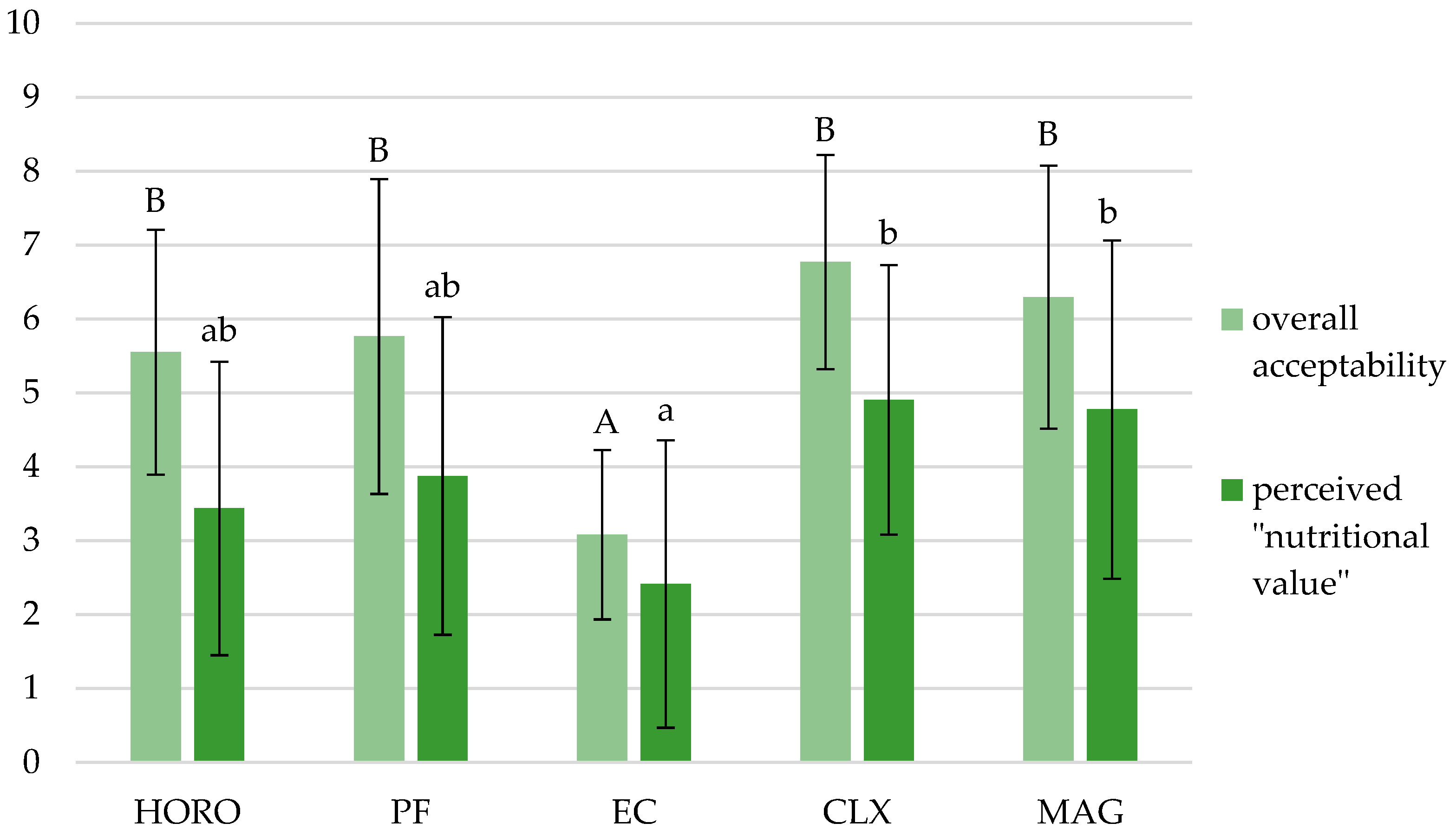

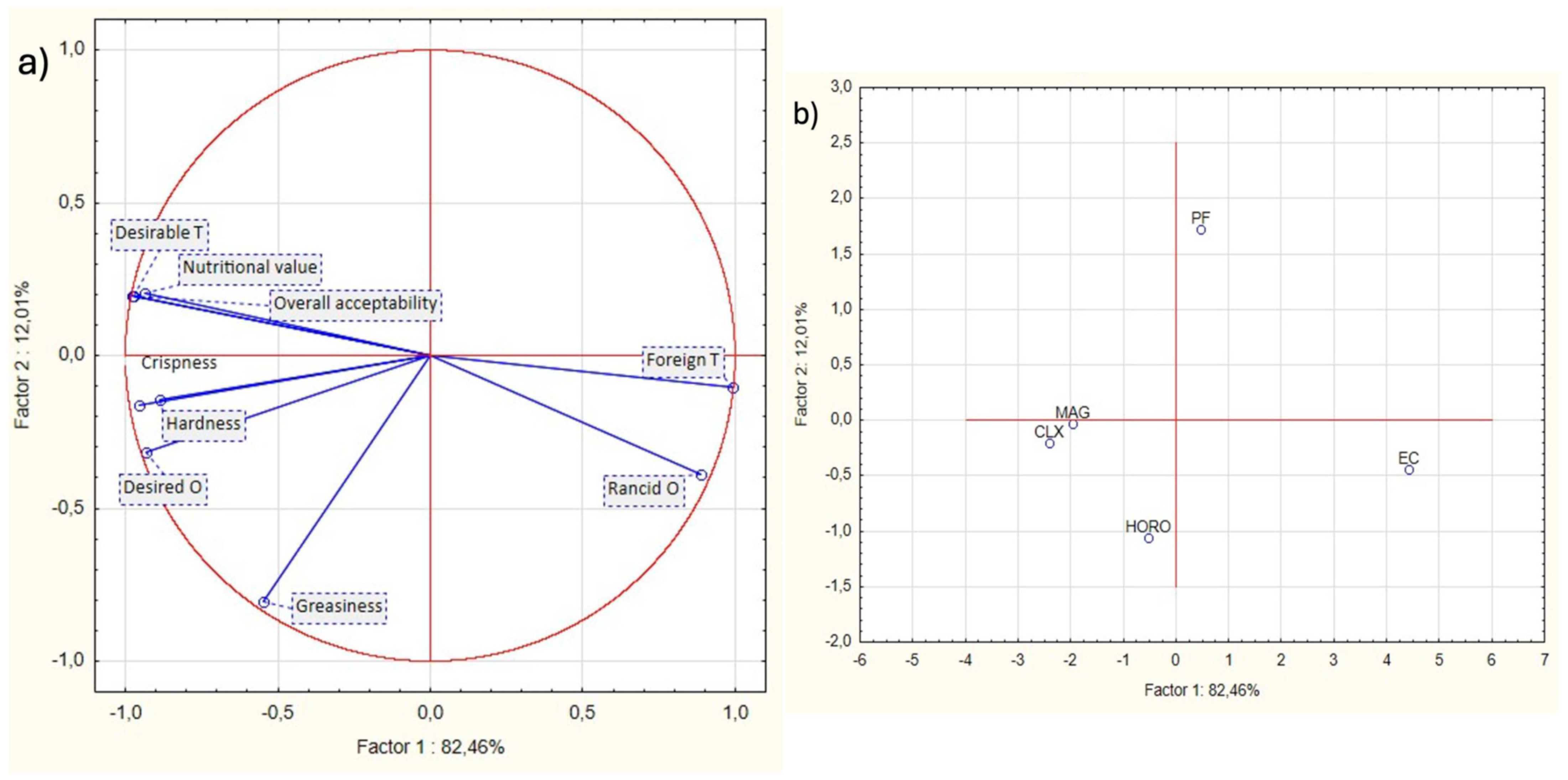
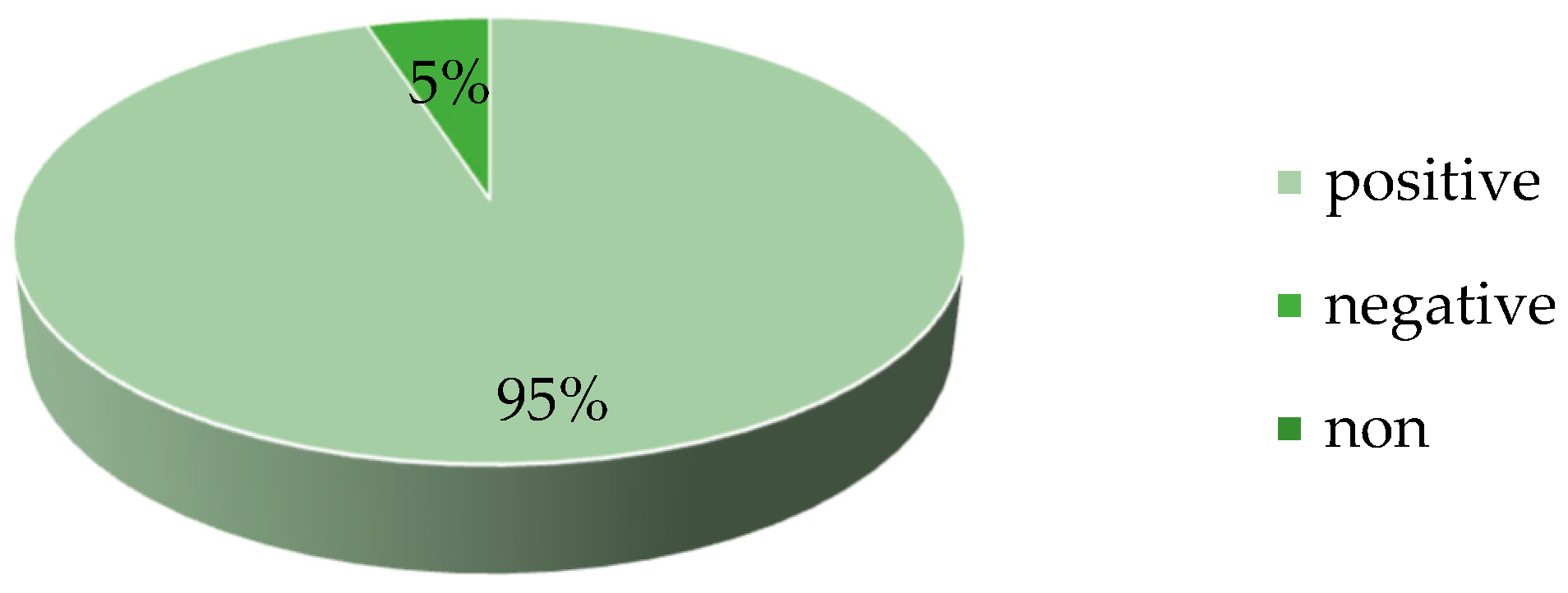
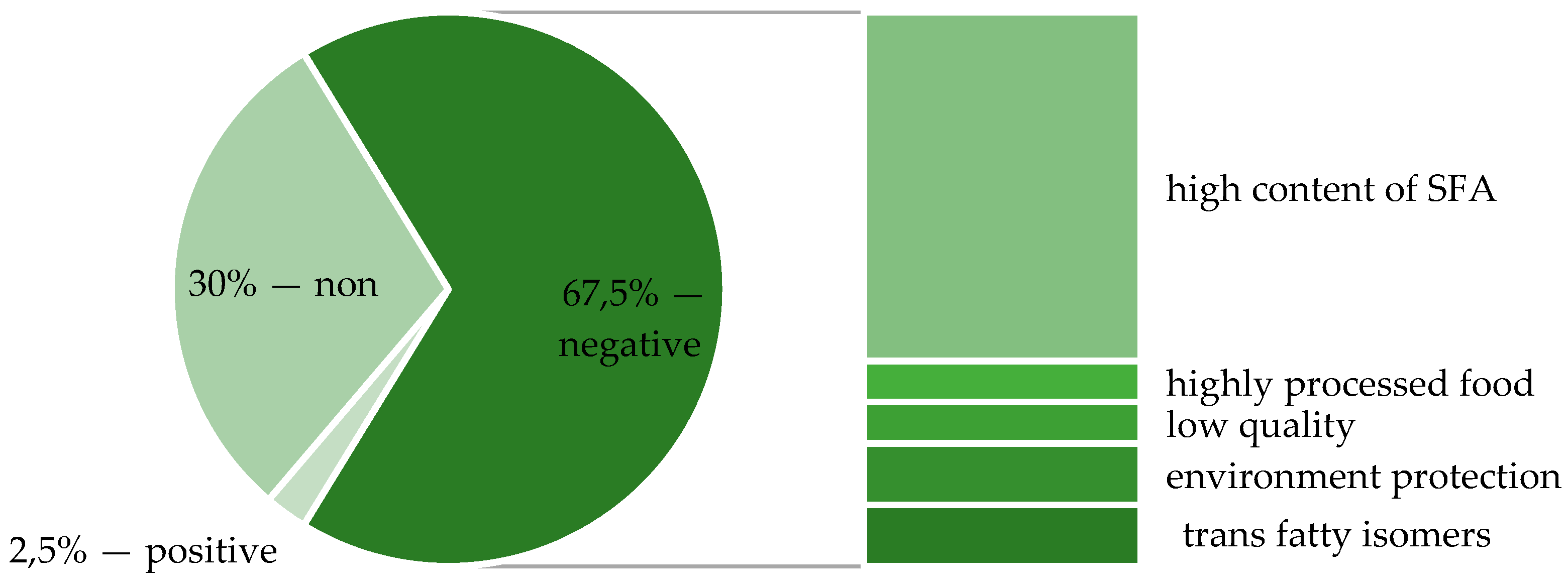



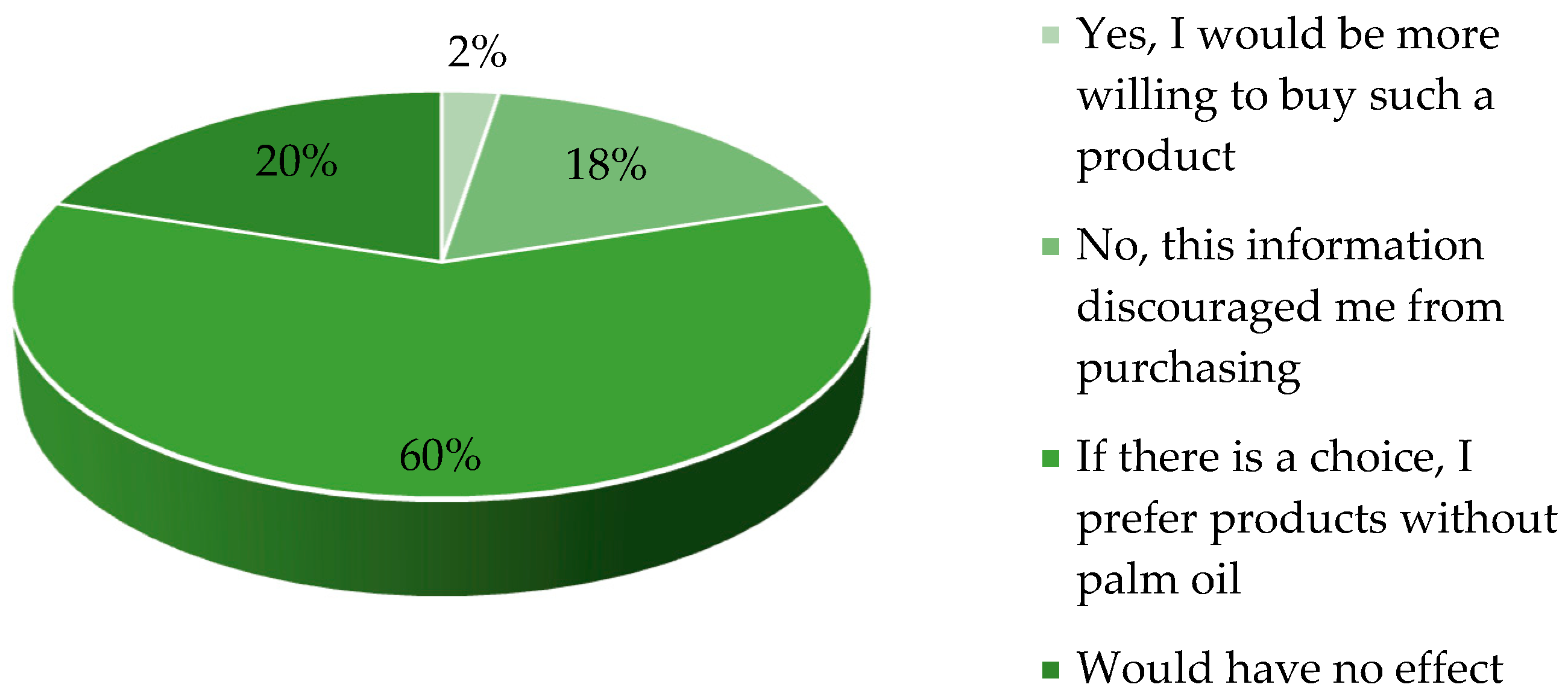
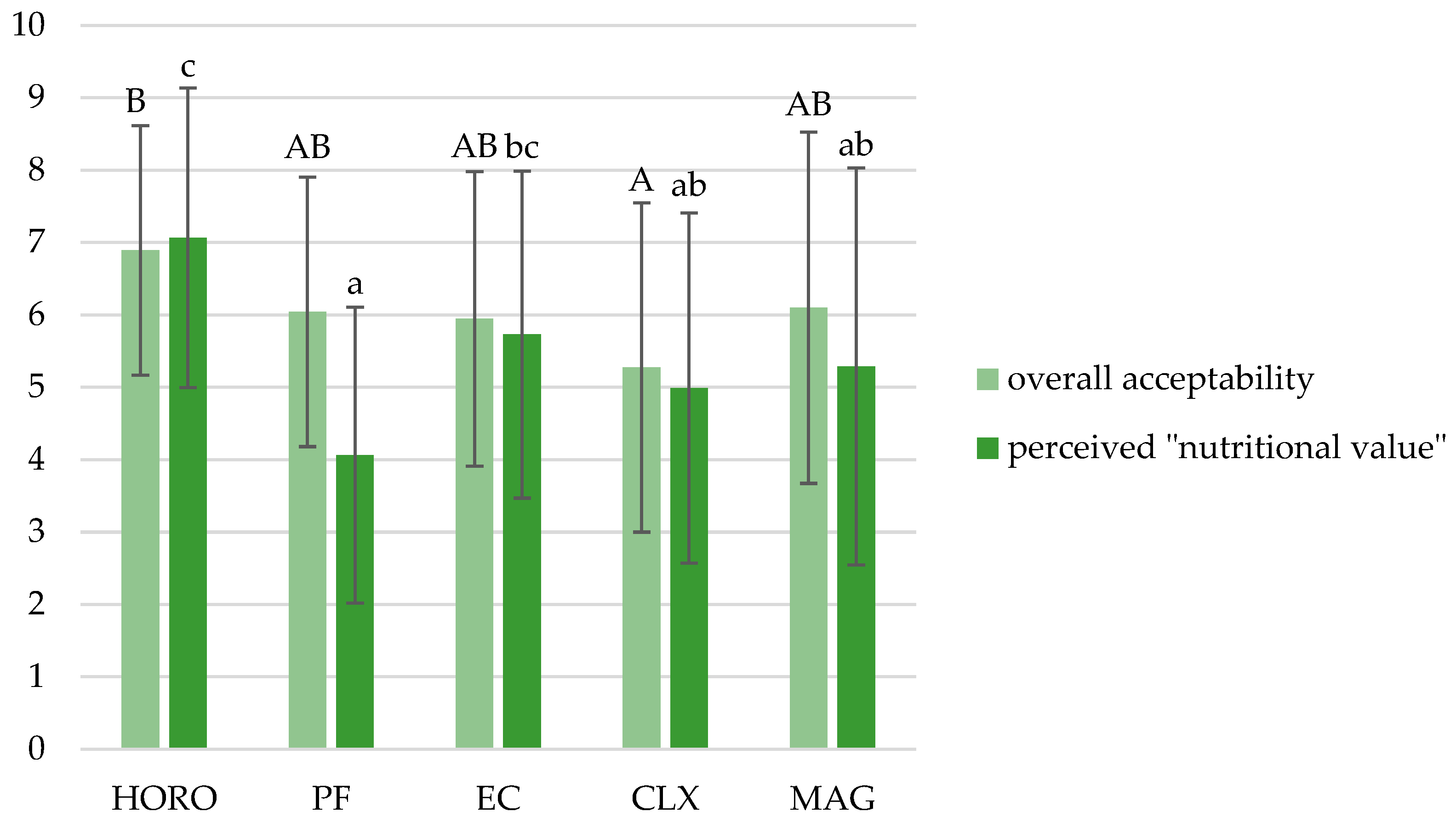

| Ingredients | PF (Control) | HORO (Control 2) | EC (with Ethylcellulose Oleogel) | CLX (with Candelilla Wax Oleogel) | MAG (with Monoacylglycerol Oleogel) |
|---|---|---|---|---|---|
| Wheat flour type 500 | 48% | 48% | 48% | 48% | 48% |
| Palm fat | 24% | - | - | - | - |
| High-oleic rapeseed oil | - | 24% | - | - | - |
| Oleogel (HORO + oleogelator) | - | - | 24% (10% EC) | 24% (3% CLX) | 24% (5% MAG) |
| Sugar | 17% | 17% | 17% | 17% | 17% |
| Lecithin | 1% | 1% | 1% | 1% | 1% |
| Baking powder | 1% | 1% | 1% | 1% | 1% |
| Water | 9% | 9% | 9% | 9% | 9% |
| Green tea extract (GTE) | - | - | 1% of the fat weight | ||
| PF | HORO | EC | CLX | MAG | |
|---|---|---|---|---|---|
| C 12:0 lauric acid | 0.2 | 0.0 | 0.0 | 0.0 | 0.0 |
| C 14:0 myristic acid | 0.9 | 0.0 | 0.0 | 0.0 | 0.0 |
| C 16:0 palmitic acid | 41.9 | 3.4 | 3.4 | 3.5 | 3.7 |
| UFA | 55.2 | 94.8 | 94.1 | 93.2 | 93.1 |
| HPI | 1.2 | 27.9 | 27.7 | 26.6 | 25.2 |
| PF | HORO | EC | CLX | MAG | |
|---|---|---|---|---|---|
| Odour | |||||
| Rancid | 3.1 ± 2.2 ab | 3.1 ± 2.2 ab | 5.4 ± 3.1 b | 3.0 ± 1.3 ab | 2.4 ± 1.8 a |
| Waxy | 3.6 ± 2.8 a | 2.7 ± 1.9 a | 3.7 ± 2.2 a | 3.8 ± 2.2 a | 4.1 ± 2.8 a |
| Tea | 3.4 ± 2.4 a | 3.4 ± 2.4 a | 2.0 ± 2.3 a | 3.2 ± 2.9 a | 3.5 ± 2.8 a |
| Desired | 4.8 ± 2.3 a | 5.6 ± 2.2 a | 4.2 ± 2.0 a | 5.6 ± 1.8 a | 5.6 ± 1.5 a |
| Appearance | |||||
| Greasiness | 4.3 ± 2.5 b | 6.7 ± 2.1 a | 5.4 ± 1.8 ab | 6.6 ± 2.0 a | 6.7 ± 2.3 a |
| Color | 2.3 ± 2.0 a | 3.0 ± 1.7 a | 3.4 ± 1.8 a | 4.2 ± 1.9 a | 3.8 ± 2.2 a |
| Cracks | 5.2 ±2.4 a | 5.4 ± 3.1 a | 4.8 ± 2.0 a | 3.9 ± 2.5 a | 3.6 ± 2.5 a |
| Texture | |||||
| Hardness | 3.4 ± 2.1 a | 3.8 ± 1.9 a | 2.8 ± 2.4 a | 4.7 ± 2.4 a | 3.7 ± 2.8 a |
| Crispness | 6.8 ± 2.2 ab | 7.6 ± 1.3 a | 5.7 ± 2.4 b | 7.5 ± 1.2 ab | 7.6 ± 1.7 a |
| Waxy mouthfeel | 4.0 ± 2.0 a | 4.1 ± 2.0 a | 5.6 ± 2.6 a | 5.0 ± 2.2 a | 5.3 ± 2.4 a |
| Taste | |||||
| Foreign | 3.8 ± 3.1 a | 3.6 ± 2.4 a | 6.4 ± 2.5 b | 2.6 ±1.9 a | 2.5 ±1.6 a |
| Sweet | 5.7 ± 2.1 a | 7.0 ± 1.8 a | 5.0 ± 2.5 a | 6.8 ±2.1 a | 6.8 ±2.2 a |
| Rancid | 3.1 ± 2.5 ab | 2.8 ± 2.1 a | 5.4 ± 3.2 b | 2.4 ±1.6 a | 1.8 ± 1.8 a |
| Waxy | 2.1 ± 1.6 a | 2.6 ± 1.5 a | 2.7 ± 2.2 a | 2.7 ± 1.6 a | 1.8 ± 1.0 a |
| Desired | 5.7 ± 2.4 a | 5.7 ± 1.9 a | 2.7 ± 1.8 b | 6.5 ± 1.7 a | 6.3 ± 1.4 a |
| Variables | Factor 1 | Factor 2 |
|---|---|---|
| Rancid odour | 0.888183 | −0.390700 |
| Desirable aroma | −0.932825 | −0.316582 |
| Greasiness | −0.549176 | −0.807625 |
| Hardness | −0.885510 | −0.143157 |
| Crispness | −0.955033 | −0.163675 |
| Foreign taste | 0.992713 | −0.104471 |
| Desirable taste | −0.971955 | 0.194369 |
| Overall acceptability | −0.976755 | 0.197269 |
| Nutritional value | −0.938046 | 0.202122 |
Disclaimer/Publisher’s Note: The statements, opinions and data contained in all publications are solely those of the individual author(s) and contributor(s) and not of MDPI and/or the editor(s). MDPI and/or the editor(s) disclaim responsibility for any injury to people or property resulting from any ideas, methods, instructions or products referred to in the content. |
© 2025 by the authors. Licensee MDPI, Basel, Switzerland. This article is an open access article distributed under the terms and conditions of the Creative Commons Attribution (CC BY) license (https://creativecommons.org/licenses/by/4.0/).
Share and Cite
Onacik-Gür, S.; Zbikowska, A.; Szymańska, I.; Kowalska, M. Biscuits with Oleogels and Green Tea Extract Addition––Sensory Evaluation and Consumer Perception. Appl. Sci. 2025, 15, 10728. https://doi.org/10.3390/app151910728
Onacik-Gür S, Zbikowska A, Szymańska I, Kowalska M. Biscuits with Oleogels and Green Tea Extract Addition––Sensory Evaluation and Consumer Perception. Applied Sciences. 2025; 15(19):10728. https://doi.org/10.3390/app151910728
Chicago/Turabian StyleOnacik-Gür, Sylwia, Anna Zbikowska, Iwona Szymańska, and Małgorzata Kowalska. 2025. "Biscuits with Oleogels and Green Tea Extract Addition––Sensory Evaluation and Consumer Perception" Applied Sciences 15, no. 19: 10728. https://doi.org/10.3390/app151910728
APA StyleOnacik-Gür, S., Zbikowska, A., Szymańska, I., & Kowalska, M. (2025). Biscuits with Oleogels and Green Tea Extract Addition––Sensory Evaluation and Consumer Perception. Applied Sciences, 15(19), 10728. https://doi.org/10.3390/app151910728









